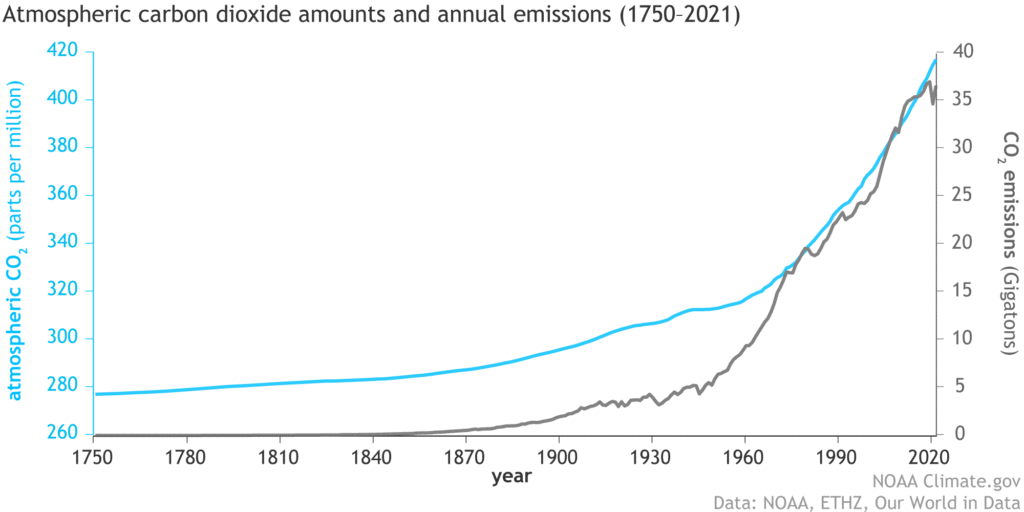
“Climate models,” according to Daniel Baer and Noah Gordon, in the Washington Post, here, “are complicated things. They must consider a staggering number of mathematical and physical variables to predict, for instance, how emitting a given amount of carbon dioxide will change the flows of air, water and heat between the atmosphere and the oceans. More sophisticated projections go further, showing how temperature changes will affect rainfall in a certain region, which in turn will affect crop yields and, as a result, the carbon cycle.”
However, as illustrated above, from “Climate.gov,” here, atmospheric Carbon Dioxide concentrations have increased close to 50% since 1750, when they were under 280 ppm, to around 420 ppm today.
The models provide sophisticated arguments supporting what we all know is happening. They are more complex now because the computers we use to develop them are more powerful. But Svente Ahhrenius, 1859-1907, realized in 1896, that “if [atmospheric carbon dioxide] levels increased by 50%, the planet would experience a warming of between 5 and 6°C…. In addition, [he] identified human industrial activity as the main source of new CO2 into the atmosphere.” See: Svante Arrhenius, the Man Who Foresaw Climate Change | OpenMind.
The simplest model requires a bit of high school chemistry, and a basic wholistic approach.
Here’s the chemistry:
Coal: C + O2 –> CO2
Methane, the simplest hydrocarbon: CH4 + 2O2 –> CO2 + 2H2O
When we look at those 2 equations in the context of burning billions of barrels of oil per day, hundreds of billions per year, over 1.0 trillion every 3 years, and trillions of tons of coal, and consider that this has taken place over a period of decades, and that we are now emitting 35 to 40 gigatons – billion tons – of CO2 per year … the amounts of CO2 and water vapor that humanity has pumped into the atmosphere and oceans is obviously staggering.
What we’ve doing for the last 126 years, since Ahhrenius published his research on climate change, is extract an increasing amount of carbon and hydrocarbon from beneath the surface of the earth, and burn it, pulling subterranean carbon and hydrogen out of the ground, and combining it with atmospheric oxygen as atmospheric carbon dioxide and water vapor.
According to NOAA, here, the world’s ocean has become 30% more acidic in the 200-plus years since the beginning of the industrial revolution.
We don’t use leaves, wood, bamboo, or farm waste, which are renewable resources, in power plants. We use coal, oil, natural gas, and uranium, which we extract from the earth.
Fossil fueled and nuclear plants are, basically, machines that burn coal or hydrocarbons or control fission in order to boil water to generate steam to turn a turbine to generate power, and use more water for cooling. It’s thermodynamically inefficient. Most of the heat is wasted, vented into the biosphere without doing useful work.
Solar, wind, hydro, geothermal, other so-called “Renewable” energy paradigms are not precisely “renewable.” More precisely they are fuel-free and therefore largely waste free. Amory Lovins coined the term “Negawatts” to mean units of energy that are not needed. Similarly, solar, wind, geothermal, and hydro provide what might be called “Nega-Fuel-Watts” and “Nega-Waste-Watts.”
The Brundtland Commission, in 1987, defined “Sustainable Development” as “Development that enables the present generation to meet its needs without negatively impacting the abilities of future generations to meet their needs.”
Legalistic and pedantic as it is, It’s a good start. John Ehrenfeld, in his 2008 book, “Sustainability by Design,” (on Amazon, Better World Books) more simply, and more creatively defines it as “Enabling flourishing, on earth, forever.”
Coal, hydrocarbons, and nuclear brought us where we are today. Wind and solar, hydro in places like Niagara Falls, geothermal, tidal, other Nega-Fuel and Nega-Waste technologies meet both definitions of sustainability, will enable us to meet our needs while preserving the abilities of future generations to meet their needs and will facilitate flourishing.